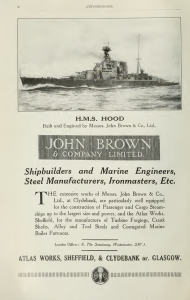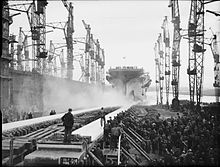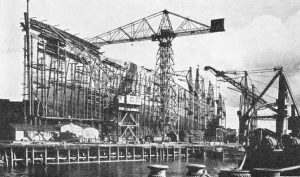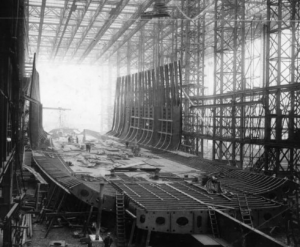The history of shipbuilding on the River Clyde is deeply intertwined with Glasgow’s transformation into an industrial powerhouse, and many shipyards contributed to this legacy. One notable shipbuilder, John Brown & Company, stood out as one of the most prestigious and influential firms on the Clyde, leaving an indelible mark on global shipbuilding history.
John Brown & Company: A History of Excellence on the River Clyde
Origins and Early Development (1820s–1851)
John Brown & Company traces its roots back to the 1820s in Sheffield, England, as a small steel manufacturing firm. John Brown, a skilled businessman, took over the company from his father in 1844 and quickly expanded its operations, focusing on the production of armour plating for warships. His innovations in steel production led him to work with British naval shipbuilders, solidifying his reputation as a key figure in naval armaments.
In 1851, John Brown made a pivotal decision to enter the shipbuilding industry. He purchased the Clydebank Iron Shipyard, originally founded in 1847 by James and George Thomson. Located on the north bank of the River Clyde near Glasgow, this acquisition set the stage for John Brown & Company to become one of the premier shipbuilders in the world.
Expansion and the Birth of the Clydebank Shipyard (1851–1890)
Following its acquisition of the Clydebank Iron Shipyard, John Brown & Company began constructing a wide range of vessels, including merchant ships, passenger liners, and naval warships. The company expanded rapidly, investing in new technologies and infrastructure to accommodate the growing demand for larger, more advanced ships.

Warships and Armour Plate Manufacturing: Brown’s background in steel production allowed the company to innovate in armour-plated warships, marking a new era of naval warfare. The Clydebank yard was outfitted with cutting-edge facilities to produce both the ships and the armour that protected them.
Shift to Larger Passenger Liners: As the 19th century progressed, demand for ocean liners grew alongside the rise of transatlantic travel. John Brown & Company was well-positioned to capitalize on this trend, producing some of the most luxurious and technically advanced ships of the era.

The Golden Age of Shipbuilding: Clydebank’s Global Prestige (1890–1939)
The late 19th and early 20th centuries marked the golden age of John Brown & Company. During this time, the company was responsible for building some of the most famous vessels in maritime history.
Key Ships Built by John Brown & Company
RMS Lusitania (1907): One of the most famous ships built at Clydebank was the RMS Lusitania. This luxury liner, constructed for the Cunard Line, was designed to be fast and opulent, serving the growing transatlantic passenger market. Tragically, Lusitania was sunk by a German U-boat in 1915, an event that contributed to the United States’ entry into World War I.
RMS Queen Mary (1934): The RMS Queen Mary, also built for Cunard, was a symbol of British engineering prowess and luxury. Launched in 1934, it became one of the most famous ocean liners in the world, competing with other liners like RMS Titanic and SS Normandie.

HMS Hood (1918): A battlecruiser that would go down in naval history, HMS Hood was launched by John Brown & Company in 1918. It became a symbol of British naval power during the interwar period, though it tragically sank during World War II in 1941.
The Rise of Ocean Liners
The early 20th century was a boom period for transatlantic passenger travel. John Brown & Company became renowned for building luxurious and state-of-the-art liners that catered to wealthy passengers crossing the Atlantic. With Clydebank at the helm, the company built some of the largest and fastest ocean liners, including the aforementioned RMS Queen Mary and RMS Queen Elizabeth, the latter of which was completed in 1939 and went on to serve as a troopship during World War II.
World War I and Interwar Period (1914–1939)
World War I saw a shift in production as the demand for military vessels surged. The Clydebank yard transitioned to building destroyers, battleships, and other naval vessels. However, after the war, the company faced economic difficulties due to the declining demand for military ships and the global economic downturn.
The interwar period was marked by competition with other shipbuilders, technological innovations in ship design, and fluctuating demand for ocean liners and naval vessels. John Brown & Company continued to innovate, but the world’s changing economic landscape posed significant challenges.
World War II and the Postwar Era (1939–1950s)
During World War II, John Brown & Company once again became a critical part of the British war effort. The Clydebank yard produced several notable warships during this time, including aircraft carriers and destroyers. The shipyard was also a target for German bombing raids, with Clydebank suffering heavy damage during the Clydebank Blitz in 1941.
After the war, the company shifted focus back to civilian shipbuilding, but the global market was changing. Advances in ship design, shifts in global trade routes, and the rise of competitors outside of Britain put pressure on the once-dominant Clyde shipyards.

Decline and Challenges in the Late 20th Century (1960s–1980s)
The post-war period saw the gradual decline of John Brown & Company, along with much of the British shipbuilding industry. A combination of factors led to this decline:
Global Competition: Shipbuilders in Japan, South Korea, and other countries were able to produce vessels at a lower cost, which eroded the competitiveness of Clydebank’s operations.
Technological Changes: Advances in shipbuilding technology and the introduction of container ships changed the dynamics of the industry.
Economic Difficulties: By the 1960s, the British shipbuilding industry was struggling with underinvestment, outdated infrastructure, and labour disputes. John Brown & Company faced a series of financial crises that ultimately led to its nationalization in the 1970s under the Labour government’s policy to consolidate shipbuilding.
Legacy and the End of an Era (1980s–2000s)
In the 1980s, John Brown & Company was absorbed into the state-owned British Shipbuilders, and the Clydebank yard gradually wound down its operations. The last ship built at the yard was launched in 1972, marking the end of nearly 150 years of shipbuilding history on the Clyde.
Though shipbuilding on the Clyde declined in the latter half of the 20th century, John Brown & Company’s legacy remains significant. The ships it produced—luxury liners, warships, and innovative vessels—helped shape maritime history and contributed to the rise of the United Kingdom as a naval and industrial power.

